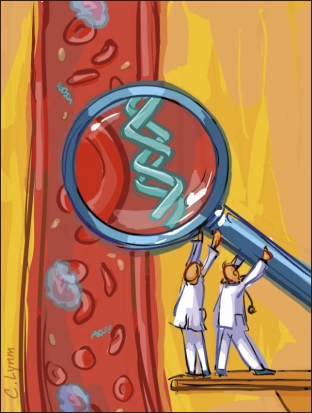New research is being carried out in the field of oncopathology, in particular in the direction of breast cancer. Because the release of tumor-associated DNA complexes into the circulation is common in patients with cancer, plasma or serum DNA screening can provide valuable information on genetic and epigenetic profiles associated with breast cancer development, progression, and response to therapy. Quantitative testing of circulating DNA can provide information about the presence of tumor masses, and their molecular characterization can help clarify important tumor characteristics relevant to the choice of targeted therapy in individual patients.
Circulating DNA analysis in breast cancer
Analysis of circulating DNA can provide important prognostic information in each individual case of breast cancer. The presence of circulating, cell-free nucleic acids in the blood was first described by Mandel and Metais in 1948. Thirty years later, Leon et al. showed that breast cancer patients had increased serum levels of cell-free DNA (cfDNA) in the blood circulation. They detected a wide range of DNA, from 0 to 2000 ng/mL, using radioimmunoassay.
In 1999, Silva et al. discovered genetically altered cfDNA in the plasma of breast cancer patients.
These observations have led to intensive quantitative and qualitative studies of cfDNA in breast cancer patients at the present time.
Breast cancer:
- why does cfDNA increase in breast cancer;
- features of clinical assessment of circulating DNA in patients with breast cancer;
- The importance of circulating DNA in the treatment of breast cancer.
Why does cfDNA increase in breast cancer
 The release of cfDNA into the bloodstream occurs from a variety of sources, including the primary tumor, tumor cells that circulate in the peripheral blood, metastatic deposits present at distant sites, and normal cell types such as hematopoietic and stromal cells. Thus, both tumor and normal cfDNA circulate in the bloodstream of cancer patients. The rapid increase in its blood level during tumor development is mainly due to the excessive release of DNA by apoptotic and necrotic cells. Decreased clearance of cfDNA caused by organ dysfunction during systemic inflammation may also contribute to increased levels in the blood of cancer patients.
The release of cfDNA into the bloodstream occurs from a variety of sources, including the primary tumor, tumor cells that circulate in the peripheral blood, metastatic deposits present at distant sites, and normal cell types such as hematopoietic and stromal cells. Thus, both tumor and normal cfDNA circulate in the bloodstream of cancer patients. The rapid increase in its blood level during tumor development is mainly due to the excessive release of DNA by apoptotic and necrotic cells. Decreased clearance of cfDNA caused by organ dysfunction during systemic inflammation may also contribute to increased levels in the blood of cancer patients.
Peculiarities of clinical assessment of circulating DNA in patients with breast cancer
Due to reduced cell turnover and more efficient removal of defective cells from the circulating blood by phagocytes, the concentration of cfDNA in healthy individuals is low. Typically, cfDNA is cleared from the blood by the liver and kidneys and has a half-life of 10 to 15 minutes. cfDNA size may indicate its source:
- apoptotic cells form 180-200 basic pairs of DNA fragments;
- necrotic cells secrete DNA fragments with a higher molecular weight - more than 10 000 pairs.
Evaluation of cfDNA species such as cell-free mitochondrial DNA is also clinically relevant in breast cancer.
The importance of circulating DNA in the treatment of breast cancer
In the blood, cfDNA circulates primarily as nucleosomes, which are the nuclear complexes of histones and DNA.
Complexes cfDNA and can be very valuable for monitoring cytotoxic therapy in breast cancer, in particular, for early evaluation of the effectiveness of therapy.
Combinations of this study with other oncological or apoptotic biomarkers have been proposed to improve the sensitivity of detecting response to cytotoxic chemotherapy. In addition, during neoadjuvant chemotherapy, patients who did not improve had significantly higher levels of circulating nucleosomes than patients in remission, indicating that such studies provide valuable information for diagnosing and predicting the response of patients with cancer. breast for therapy.







Add a comment